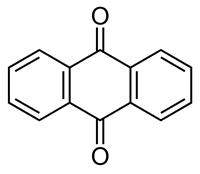Anthraquinone: Difference between revisions
Jump to navigation
Jump to search

imported>Howard C. Berkowitz (New page: {{subpages}} left|thumb|200px|Anthraquinone molecular structure '''Anthraquinone''' is the class-defining compound for a number of naturally-occurring plant pig...) |
imported>Howard C. Berkowitz No edit summary |
||
| Line 10: | Line 10: | ||
| url = http://www.ncbi.nlm.nih.gov/pubmed/8022857}}</ref> | | url = http://www.ncbi.nlm.nih.gov/pubmed/8022857}}</ref> | ||
The plant ''[[Rheum palmatum]]'', called [[Indian rhubarb]] in North America and also used in [[traditional Chinese medicine]] is rich in anthraquinones. | The plant ''[[Rheum palmatum]]'', called [[Indian rhubarb]] in North America and also used in [[traditional Chinese medicine]] is rich in anthraquinones. | ||
Anthraquinone derivatives called sennosides are used as cathartics; they are the active principle in [[senna extract]]. | |||
==References== | ==References== | ||
{{reflist|2}} | {{reflist|2}} | ||
Latest revision as of 14:58, 17 August 2010
Anthraquinone is the class-defining compound for a number of naturally-occurring plant pigments. Anthraquinone itself has been associated with causing liver, bladder and kidney cancers, and other non-neoplastic disorders.[1]. It also, however, has been a starting point for developing antineoplastic agents, especially the anthracycline agents, of which doxorubricin (Adriamycin) is best known. [2]
The plant Rheum palmatum, called Indian rhubarb in North America and also used in traditional Chinese medicine is rich in anthraquinones.
Anthraquinone derivatives called sennosides are used as cathartics; they are the active principle in senna extract.
References
- ↑ TR-494 Anthraquinone, National Toxicology Program, U.S. Department of Health and Human Services
- ↑ Lown JW (1993 Nov), "(Abstract) Anthracycline and anthraquinone anticancer agents: current status and recent developments.", Pharmacol Ther 60 (2): 185-214
